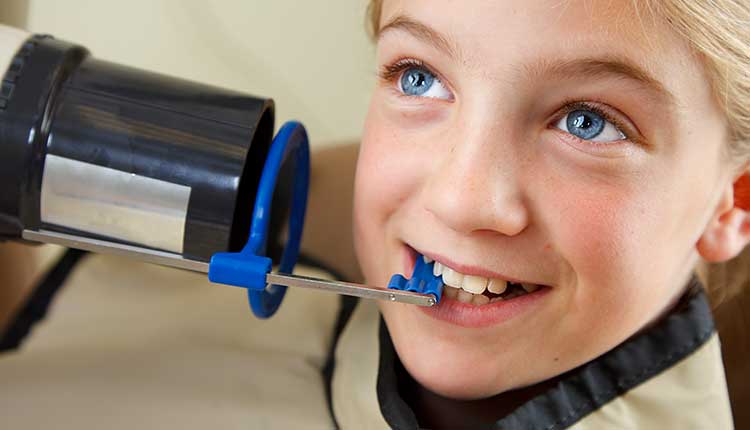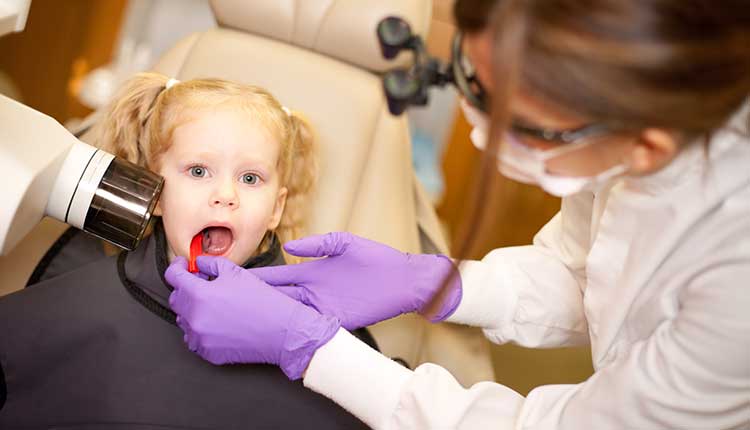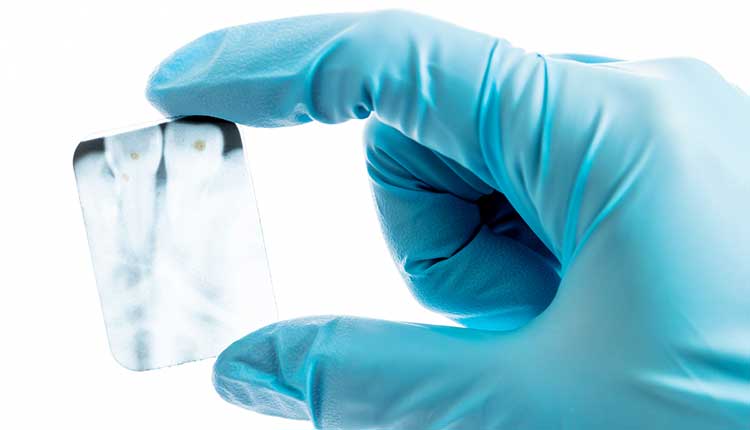
The National Council of Radiation Protection and Measurements (NCRP) provides recommendations on radiation protection in its Report No. 177 “Radiation Protection in Dentistry and Oral & Maxillofacial Imaging.” It provides 61 recommendations based on the ALARA (as low as reasonably achievable) principle, which means every effort should be made to reduce a patient’s exposure to radiation. The report states that lead aprons are not required if all recommendations are followed because radiation doses to the reproductive region have decreased due to advances in dental radiography. However, individual states may still require lead aprons and, therefore, must be used during intraoral and extraoral radiographic examinations.
Photo Credit: yoh4nn / E+

Thyroid Collars
Thyroid collars are required for radiographic examinations if they do not interfere with the procedure. The thyroid gland is an extremely radiosensitive organ and is susceptible to tumors due to radiation exposure. Thyroid collars should be used during bitewing and full-mouth series examinations, but not during panoramic imaging.
Photo Credit: RichLegg / E+

Protecting Operators and Patients
The report’s recommendations focus on a wide range of topics including strategies to protect operators and patients, such as the use of: selection guidelines for all images, the fastest image receptor available, rectangular collimation, correct exposure factors, and proper technique. The implementation of digital imaging is one of these recommendations, as the amount of radiation needed to expose the receptor is less compared to film. Digital radiographs are obtained using a sensor, such as the charge-coupled device (CCD), complementary metal oxide semiconductor, and photostimulable phosphor (PSP) plate. A full-mouth series using D-speed film and a circular position-indicating device (PID) provide an effective dose of 388 µSv, while the use of PSP plates or F-speed film provide a dose close to 171 µSv and CCD use is 85 µSv. If the PID is equipped with rectangular collimation, the effective dose is 35 µSv when using PSP plates or F-speed film and 17 µSv when using CCD.
Photo Credit: ideabug / iStock / Getty Images Plus

Effective Dosage
Digital panoramic examinations provide an effective dose that ranges from 14.2 µSv to 24.3 µSv. While these values are associated with dosimeters placed in the head and neck region, a recent study using cone-beam computed tomography (CBCT) determined effective doses for the chest and reproductive areas of the body. The study found an average effective dose of 0.1 µSv to the reproductive region when using a lead apron and 0.8 µSv when not using a lead apron. The study also concluded the lead apron offered close to a 93% reduction in the radiation exposure to the female chest. CBCT provides an effective dose higher than traditional two-dimensions imaging and, on average, the effective dose ranges from 84 µSv for a small field of view to 212 µSv for a large field of view. When comparing these effective dose values to annual radiation doses, an individual receives a dose of 3.0 mSv from medical radiation, which includes dental imaging. The annual medical radiation dose is almost half of the total annual dose of 6.2 mSv.
Photo Credit: baona / iStock / Getty Images Plus

Risks vs Benefits
While advances in dental radiology have reduced radiation doses, ionizing radiation is still considered detrimental to human tissue. Lead aprons and thyroid collars offer protection from scatter radiation reducing a patient’s overall radiation dose. Oral health professionals are obligated to protect patients by making every effort to reduce their radiation exposure. If all recommendations in the NCRP Report No. 177 are followed, then lead aprons are not required for dental radiographic examinations unless required by the state. Thyroid collars are necessary unless there is a possibility of them interfering with the examination.

